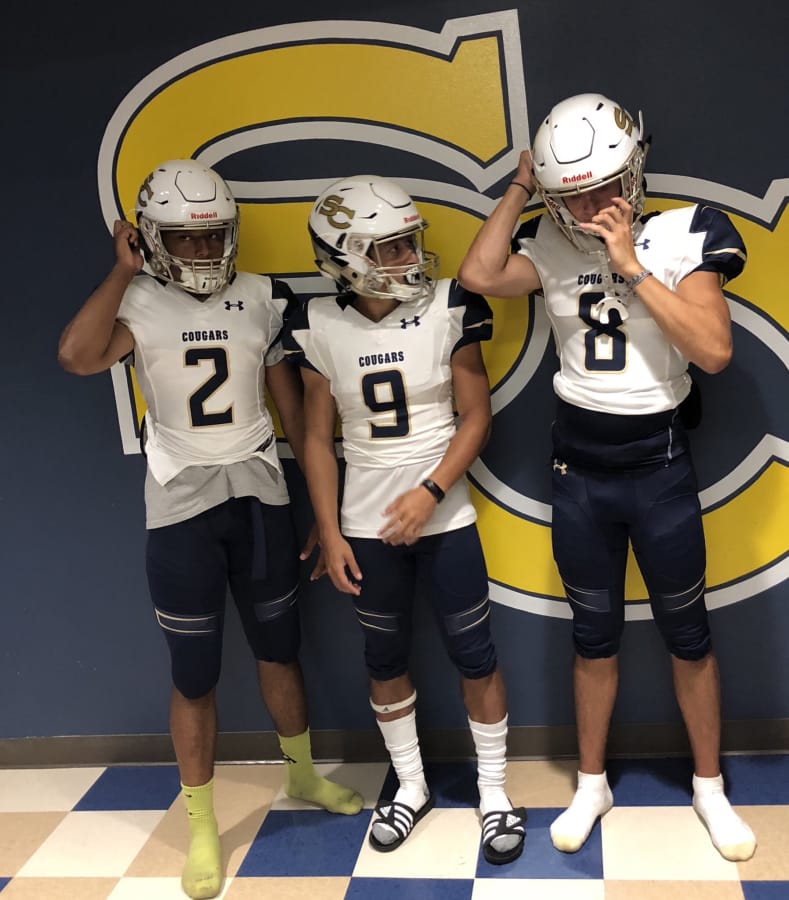Taj Muhammad has read the headlines, heard warning signs, but at this point, he’s not paying much attention to the dangers of head injuries in football.
The running back/defensive back trusts the safeguards in place to protect players, such as methods of tackling that his coaches at Seton Catholic are employing in an effort to lessen head impact.
“I signed up for it,” Muhammad said. “I know there’s dangers of getting head injuries but it’s the game I love so I’ll risk whatever to play the game I love.”
For Muhammad and his teammates, there’s a new safeguard. Starting this year, Seton Catholic has implemented flash drive-sized sensors that fit in each player’s helmet to track impact levels during practices and games in an effort to monitor and prevent head trauma.
It’s an effort Seton head coach Will Ephraim has taken to develop the “most efficient practice,” complete with more tackling and less head impact. Seton is the only program in Clark County to take this measure to track head trauma.
The “Cue sensors,” which go for around $99 apiece, are sold by Athlete Intelligence, a Kirkland-based company that sells different types of sensors that compile hit detection data to help coaches and trainers identify head trauma more precisely and create training plans to minimize head contact.
The product’s utility is twofold: alerting coaches and trainers the impact level of a hit in the heat of a moment, and then studying the sensor’s results over time by age, position and drill.
“We’re starting to see patterns and starting to collect larger amounts of data over time, and we start to look for what we call coachable moments,’ ” Athlete Intelligence CEO Jesse Harper said.
When a player is hit, the sensor will provide an impact reading to which coaches and trainers have live access. Anything in the 70 to 90 range indicates a potential concussion. From there the player would follow the team protocol of exiting the practice or game to be evaluated by a trainer.
In its first live action game of the 2018 season, Seton Catholic played with the sensors last weekend in a jamboree in Philomath, Ore. To Ephraim’s dismay, only four of them were charged and operating.
The biggest hit, he said, came by way of a freshman cornerback and registered at a 54 — some 16 points below the concussion range.
The live results are supposed to capture what coaches otherwise might miss in the heat of a game.
“That’s why we have these things — we don’t get it all,” Ephraim said. “It’s extra eyes.”
When thinking about the potential of a coach missing a damaging hit, one particular game comes to mind for Ephraim. Two seasons ago, a middle linebacker was having what the coach described as a “great game,” until teammates pointed out uncharacteristic behavior at halftime.
Ephraim checked on him, and subsequently ruled the linebacker out of the remainder of the game. The player went on to miss the rest of the season.
After closely reviewing the film, the Seton coaches noticed the initial hit to the head came on the first series of the game, followed by hit after hit throughout the first half.
“If we had the system in hand, we would have caught it right away and he could have been diagnosed a little bit earlier,” Ephraim said.
Having a detection system in place puts Ephraim’s mind at ease.
And for a team with participation in the 20s, and multiple players starting on both sides of the ball, limiting head injuries is perhaps more of an urgent concern.
“We’d hate for somebody to go out with a concussion because they already got buzzed in the head once or twice, then they just want to keep going and tough it out,” junior receiver/safety Mikey Silveira Jr. said. “These helmet cues would help a lot with hitting. Last thing we need is people to start dropping like flies.”
Though the WIAA has rules in place preventing players from using technology mounted on the outside of helmets, hit sensors such as the “Cue system” are encouraged.
“We have no restrictions on those during games,” WIAA assistant executive director John Miller said. “We have a number of schools utilizing technology similar to that.”
Ephraim heard about the sensors at a coaching clinic in February.
This is the first high school season since the Cue sensor has gone to market.
“We don’t say things like, ‘We’ll lower your rate of concussions by X percent,’ ” Harper said. “But what we know is we get feedback regularly that teams have modified practices, identified issues that they may not have seen otherwise that they’ve seen a less than with the number concussions they’re suffering each year.”
And for players like Muhammad, whose positions leave him susceptible to a high volume of hits, the sensors give him one more safeguard.




